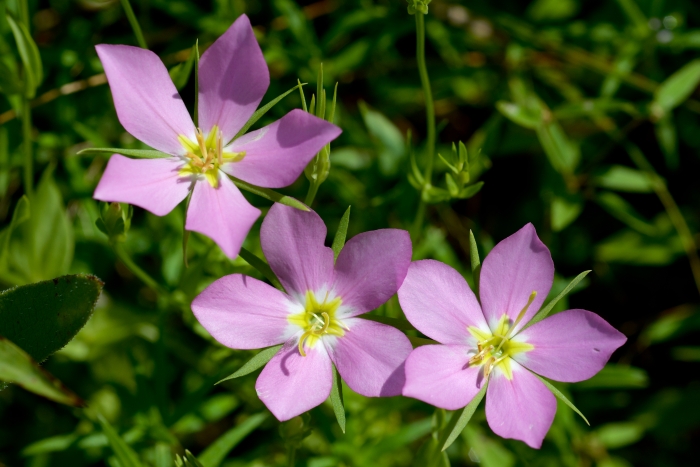Texas Star
(Sabatia campestris)
Texas Star (Sabatia campestris)
/
/

Eric Hunt
CC BY-SA 4.0
Image By:
Eric Hunt
Recorded By:
Copyright:
CC BY-SA 4.0
Copyright Notice:
Photo by: Eric Hunt | License Type: CC BY-SA 4.0 | License URL: https://creativecommons.org/licenses/by-sa/4.0 | Uploader: Eric in SF | Publisher: Wikimedia Commons | Title: Sabatia_campestris_Arkansas.jpg | Notes: |



















































Estimated Native Range
Summary
Sabatia campestris, commonly known as Texas Star, is an annual herb that is native to wet prairies and meadows in the Central United States. It typically grows to 15–25 cm (6–10 in) tall and features pairs of opposite leaves that are 8–40 mm long and 5–20 mm wide. The Texas Star is notable for its showy flowers, which are produced in open, long-stalked cymes at the top of the stems. Each flower has a corolla about 40 mm in diameter, with five pink (rarely white) lobes that have bluntly acute apices, and a contrasting bright yellow central ’eye’. The flowers are hermaphroditic, containing both male and female organs, and they bloom in the summer months. After flowering, the plant produces a fruit that is a capsule containing numerous small seeds.
Texas Star is valued for its striking flowers and is often used in wildflower gardens, meadow plantings, and as a border plant. It is also a popular choice for pollinator gardens due to its attractiveness to bees and butterflies. In cultivation, it requires moist soil and can tolerate partial to full sun exposure. It is adaptable to a range of soil drainage conditions, from slow to fast. While it is generally easy to maintain, it may require additional watering during dry periods. Gardeners should be aware that Sabatia campestris is an annual and will need to be replanted each year or allowed to self-seed.CC BY-SA 4.0
Texas Star is valued for its striking flowers and is often used in wildflower gardens, meadow plantings, and as a border plant. It is also a popular choice for pollinator gardens due to its attractiveness to bees and butterflies. In cultivation, it requires moist soil and can tolerate partial to full sun exposure. It is adaptable to a range of soil drainage conditions, from slow to fast. While it is generally easy to maintain, it may require additional watering during dry periods. Gardeners should be aware that Sabatia campestris is an annual and will need to be replanted each year or allowed to self-seed.CC BY-SA 4.0
Plant Description
- Plant Type: Herb
- Height: 0.5-0.8 feet
- Width: 0.125-0.2 feet
- Growth Rate: Moderate
- Flower Color: Purple, Pink
- Flowering Season: Spring, Summer
- Leaf Retention:
Growth Requirements
- Sun: Full Sun
- Water: Medium
- Drainage: Slow, Medium, Fast
Common Uses
Bird Garden, Butterfly Garden, Low Maintenance, Showy Flowers
Natural Habitat
Wet prairies and meadows in the Central United States
Other Names
Common Names: Meadow Pink, Prairie Rose Gentian, Prairie Sabatia
Scientific Names: , Sabatia campestris, Sabatia campestris f. albiflora,
GBIF Accepted Name: Sabatia campestris Nutt.